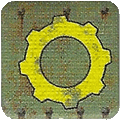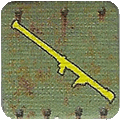As German troops poured into the Ardennes, Lt.-Col. William McKinley, grandson of the former president, formi his depleted lst Battalion, 9th Infantry Regiment, 2nd Infantry Division facing the 12th. SS "Hitler Youth" Panzer Division. The 9th Infantry had seen heavy fighting in previous weeks and had been transfered to this "quiet" sector to rest and refit before re-joining the action. Instead of rest, McKinley scrambled to position his troops to withstand the SS onslaught, with both sides determined to control the Lausdell crossroads just outside the village of Krinkelt.
This was the northern shoulder of the German offensive, and the 6th Panzer Army was determined to break through the American line of Rocherath-Krinkelt, an action that would become famous as the "twin villages." The official U.S. Army history of the battle noted: "The failure to break through at the twin villages on 18 December and so open the way south to the main armored route via Biillingen had repercussions all through the successive layers of German command on the Western Front.
...The direction of the German main effort, as a result, would shift, substituting an armored thrust against the flank for the battering-ram frontal attack against the now well-developed defenses in the area of Krinkelt-Rocherath."
| American | German | |
| Division 1 |
6 Squad Bases |
4 Panzer IVs |
| Division 2 |
3 Sherman M4A1s |
8 Squad Bases 3 SdKfz 251 Half-Tracks 3x |
| Strategy Decks | Artillery 1 Artillery 2 |
Command 1 |
| Starting Strategy Cards | 4 (1x "Increased Priority" card from Artillery I) | 2 |
| Operations Cards | - Desperate Defenders - Camouflage 002 Heavy Fog (shared) |
- Seize the Initiative 002 Heavy Fog (shared) |
| Deployment Zone | Any hexes on maps 2B, 4A, 6A, 7A, 3A, and 5A. | Any grey bordered hexes. |
| Starting Initiative |  |
|
| Objective | The Americans win if the Germans are unable to fulfill their objective by the end of round 7. | At the end of a round, the Germans win if they control the bridge hex and if at least two Panzer IVs and/or German Squads have exited the board from the blue shaded hexes. |
| Rounds | 7 | |
| Actions per turn | 3 | 3 |
| Reinforcements | - | - |
| Special Rules | The blue shaded hexes on 3A. 5A and 7A are the exit hexes for the German units (1 movement point cost). | |
| Terrain Features | The stream is Shallow. | |
| HINTS | The Americans should consider not defending with too many units forward initially, but hold hack tanks until the win Germans reveal their attack focus. | The Germans should aggressively attack the forward American positions and not worry initially about esiting the game hoard. |

 Engineer
Engineer AntiTank
AntiTank Concealed
Concealed